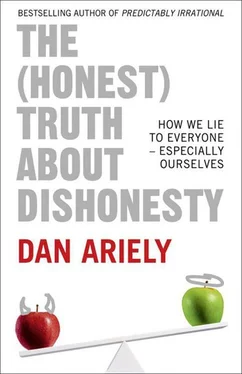Ariely, Dan - The (Honest) Truth About Dishonesty - How We Lie to Everyone – Especially Ourselves
Здесь есть возможность читать онлайн «Ariely, Dan - The (Honest) Truth About Dishonesty - How We Lie to Everyone – Especially Ourselves» весь текст электронной книги совершенно бесплатно (целиком полную версию без сокращений). В некоторых случаях можно слушать аудио, скачать через торрент в формате fb2 и присутствует краткое содержание. Жанр: Старинная литература, на английском языке. Описание произведения, (предисловие) а так же отзывы посетителей доступны на портале библиотеки ЛибКат.
- Название:The (Honest) Truth About Dishonesty: How We Lie to Everyone – Especially Ourselves
- Автор:
- Жанр:
- Год:неизвестен
- ISBN:нет данных
- Рейтинг книги:4 / 5. Голосов: 1
-
Избранное:Добавить в избранное
- Отзывы:
-
Ваша оценка:
- 80
- 1
- 2
- 3
- 4
- 5
The (Honest) Truth About Dishonesty: How We Lie to Everyone – Especially Ourselves: краткое содержание, описание и аннотация
Предлагаем к чтению аннотацию, описание, краткое содержание или предисловие (зависит от того, что написал сам автор книги «The (Honest) Truth About Dishonesty: How We Lie to Everyone – Especially Ourselves»). Если вы не нашли необходимую информацию о книге — напишите в комментариях, мы постараемся отыскать её.
The (Honest) Truth About Dishonesty: How We Lie to Everyone – Especially Ourselves — читать онлайн бесплатно полную книгу (весь текст) целиком
Ниже представлен текст книги, разбитый по страницам. Система сохранения места последней прочитанной страницы, позволяет с удобством читать онлайн бесплатно книгу «The (Honest) Truth About Dishonesty: How We Lie to Everyone – Especially Ourselves», без необходимости каждый раз заново искать на чём Вы остановились. Поставьте закладку, и сможете в любой момент перейти на страницу, на которой закончили чтение.
Интервал:
Закладка:
So did they cheat Eynav to a greater degree? They still took a bit more money than they deserved, but they cheated just as much when Tali supervised the experiments as they did when Eynav was in charge.
These results suggest that the probability of getting caught doesn’t have a substantial influence on the amount of cheating. Of course, I am not arguing that people are entirely uninfluenced by the likelihood of being caught—after all, no one is going to steal a car when a policeman is standing nearby—but the results show that getting caught does not have as great an influence as we tend to expect, and it certainly did not play a role in our experiments.
YOU MIGHT BEwondering whether the participants in our experiments were using the following logic: “If I cheat by only a few questions, no one will suspect me. But if I cheat by more than a small amount, it may raise suspicion and someone might question me about it.”
We tested this idea in our next experiment. This time, we told half of the participants that the average student in this experiment solves about four matrices (which was true). We told the other half that the average student solves about eight matrices. Why did we do this? Because if the level of cheating is based on the desire to avoid standing out, then our participants would cheat in both conditions by a few matrices beyond what they believed was the average performance (meaning that they would claim to solve around six matrices when they thought the average was four and about ten matrices when they thought the average was eight).
So how did our participants behave when they expected others to solve more matrices? They were not influenced even to a small degree by this knowledge. They cheated by about two extra answers (they solved four and reported that they had solved six) regardless of whether they thought that others solved on average four or eight matrices.
This result suggests that cheating is not driven by concerns about standing out. Rather, it shows that our sense of our own morality is connected to the amount of cheating we feel comfortable with. Essentially, we cheat up to the level that allows us to retain our self-image as reasonably honest individuals.
Into the Wild
Armed with this initial evidence against the SMORC, Racheli and I decided to get out of the lab and venture into a more natural setting. We wanted to examine common situations that one might encounter on any given day. And we wanted to test “real people” and not just students (though I have discovered that students don’t like to be told that they are not real people). Another component missing from our experimental paradigm up to that point was the opportunity for people to behave in positive and benevolent ways. In our lab experiments, the best our participants could do was not cheat. But in many real-life situations, people can exhibit behaviors that are not only neutral but are also charitable and generous. With this added nuance in mind, we looked for situations that would let us test both the negative and the positive sides of human nature.
IMAGINE A LARGEfarmer’s market spanning the length of a street. The market is located in the heart of Be’er Sheva, a town in southern Israel. It’s a hot day, and hundreds of merchants have set out their wares in front of the stores that line both sides of the street. You can smell fresh herbs and sour pickles, freshly baked bread and ripe strawberries, and your eyes wander over plates of olives and cheese. The sound of merchants shouting praises of their goods surrounds you: “Rak ha yom!” (only today), “Matok!” (sweet), “Bezol!” (cheap).
Eynav and Tali entered the market and headed in different directions, Eynav using a white cane to navigate the market. Each of them approached a few vegetable vendors and asked each of the sellers to pick out two kilos (about 4.5 pounds) of tomatoes for them while they went on another errand. Once they made their request, they left for about ten minutes, returned to pick up their tomatoes, paid, and left. From there they took the tomatoes to another vendor at the far end of the market who had agreed to judge the quality of the tomatoes from each seller. By comparing the quality of the tomatoes that were sold to Eynav and to Tali, we could figure out who got better produce and who got worse.
Did Eynav get a raw deal? Keep in mind that from a purely rational perspective, it would have made sense for the seller to choose his worst-looking tomatoes for her. After all, she could not possibly benefit from their aesthetic quality. A traditional economist from, say, the University of Chicago might even argue that in an effort to maximize the social welfare of everyone involved (the seller, Eynav, and the other consumers), the seller should have sold her the worst-looking tomatoes, keeping the pretty ones for people who could also enjoy that aspect of the tomatoes. As it turned out, the visual quality of the tomatoes chosen for Eynav was not worse and, in fact, was superior to those chosen for Tali. The sellers went out of their way, and at some cost to their business, to choose higher-quality produce for a blind customer.
WITH THOSE OPTIMISTICresults, we next turned to another profession that is often regarded with great suspicion: cab drivers. In the taxi world, there is a popular stunt called “long hauling,” which is the official term for taking passengers who don’t know their way around to their destination via a lengthy detour, sometimes adding substantially to the fare. For example, a study of cab drivers in Las Vegas found that some cabbies drive from McCarran International Airport to the Strip by going through a tunnel to Interstate 215, which can mount to a fare of $92 for what should be a two-mile journey. 1
Given the reputation that cabbies have, one has to wonder whether they cheat in general and whether they would be more likely to cheat those who cannot detect their cheating. In our next experiment we asked Eynav and Tali to take a cab back and forth between the train station and Ben-Gurion University of the Negev twenty times. The way the cabs on this particular route work is as follows: if you have the driver activate the meter, the fare is around 25 NIS (about $7). However, there is a customary flat rate of 20 NIS (about $5.50) if the meter is not activated. In our setup, both Eynav and Tali always asked to have the meter activated. Sometimes drivers would tell the “amateur” passengers that it would be cheaper not to activate the meter; regardless, both of them always insisted on having the meter activated. At the end of the ride, Eynav and Tali asked the cab driver how much they owed them, paid, left the cab, and waited a few minutes before taking another cab back to the place they had just left.
Looking at the charges, we found that Eynav paid less than Tali, despite the fact that they both insisted on paying by the meter. How could this be? One possibility was that the drivers had taken Eynav on the shortest and cheapest route and had taken Tali for a longer ride. If that were the case, it would mean that the drivers had not cheated Eynav but that they had cheated Tali to some degree. But Eynav had a different account of the results. “I heard the cab drivers activate the meter when I asked them to,” she told us, “but later, before we reached our final destination, I heard many of them turn the meter off so that the fare would come out close to twenty NIS.” “That certainly never happened to me,” Tali said. “They never turned off the meter, and I always ended up paying around twenty-five NIS.”
There are two important aspects to these results. First, it’s clear that the cab drivers did not perform a cost-benefit analysis in order to optimize their earnings. If they had, they would have cheated Eynav more by telling her that the meter reading was higher than it really was or by driving her around the city for a bit. Second, the cab drivers did better than simply not cheat; they took Eynav’s interest into account and sacrificed some of their own income for her benefit.
Читать дальшеИнтервал:
Закладка:
Похожие книги на «The (Honest) Truth About Dishonesty: How We Lie to Everyone – Especially Ourselves»
Представляем Вашему вниманию похожие книги на «The (Honest) Truth About Dishonesty: How We Lie to Everyone – Especially Ourselves» списком для выбора. Мы отобрали схожую по названию и смыслу литературу в надежде предоставить читателям больше вариантов отыскать новые, интересные, ещё непрочитанные произведения.
Обсуждение, отзывы о книге «The (Honest) Truth About Dishonesty: How We Lie to Everyone – Especially Ourselves» и просто собственные мнения читателей. Оставьте ваши комментарии, напишите, что Вы думаете о произведении, его смысле или главных героях. Укажите что конкретно понравилось, а что нет, и почему Вы так считаете.












